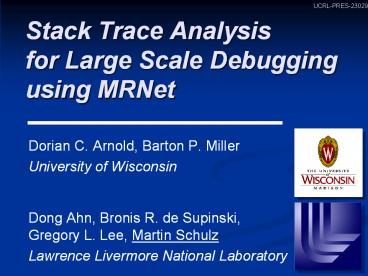Stack Trace Analysis for Large Scale Debugging using MRNet - PowerPoint PPT Presentation
1 / 24
Title:
Stack Trace Analysis for Large Scale Debugging using MRNet
Description:
Stack Trace Analysis for Large Scale Debugging using MRNet, Paradyn Week, 4/30-5 ... Some bugs only occur at large scales. Non-deterministic & hard to reproduce ... – PowerPoint PPT presentation
Number of Views:156
Avg rating:3.0/5.0
Title: Stack Trace Analysis for Large Scale Debugging using MRNet
1
Stack Trace Analysis for Large Scale Debugging
using MRNet
UCRL-PRES-230290
- Dorian C. Arnold, Barton P. Miller
- University of Wisconsin
- Dong Ahn, Bronis R. de Supinski,Gregory L. Lee,
Martin Schulz - Lawrence Livermore National Laboratory
2
Scaling Tools
- Machine sizes are increasing
- New cluster close to or above 10,000 cores
- Blue Gene/L over 131,000 cores
- Not only applications need to scale
- Support environment
- Tools
- Challenges
- Data collection, storage, and analysis
- Scalable process management and control
- Visualization
3
LLNL Parallel Debug Sessions
18,391sessions
(03/01/2006 05/11/2006)
4
Debugging on BlueGene/L
- Typical debug session includes many interactions
4096 is only 3 of BG/L!
5
Scalability Limitations
- Large volumes of debug data
- Single frontend for all node connections
- Centralized data analysis
- Vendor licensing limitations
- Approach scalable, lightweight debugger
- Reduce exploration space to small subset
- Online aggregation using a TBON
- Full-featured debugger for deeper digging
6
Outline
- Case study CCSM
- STAT Approach
- Concept of Stack Traces
- Identification of Equivalence Classes
- Implementation
- Using Tree-based Overlay Networks
- Data and Work Flow in STAT
- Evaluation
- Conclusions
7
Case Study CCSM
- Community Climate System Model (CCSM)
- Used to make climate predictions
- Coupled models for atmosphere, ocean, sea ice and
land surface - Implementation
- Multiple Program Multiple Data (MPMD) model
- MPI-based application
- Distinct components for each model
- Typically requires significant node count
- Models executed concurrently
- Several hundred tasks
8
Observations
- Intermittently hangs with 472 tasks
- Non-deterministic
- Only at large scale
- Appears at seemingly random code locations
- Hard to reproduce2 hangs over next 10 days (50
runs) - Current approach
- Attach to job using TotalView
- Collect stack traces from all 472 tasks
- Visualize cross-node callgraph
9
CCSM Callgraph
10
Lessons Learned
- Some bugs only occur at large scales
- Non-deterministic hard to reproduce
- Stack traces can provide useful insight
- Many bugs are temporal in nature
- Need tools that
- Combine spatial and temporal observations
- Discover application behavior
- Run effectively at scale
11
STAT Approach
- Sample application stack traces
- Across time and space
- Through third party interface
- Using a DynInst based daemon
- Merge/analyze traces
- Discover equivalent process behavior
- Group similar processes
- Facilitate scalable analysis/data presentation
- Leverage TBON model (MRNet)
- Communicate traces back to a frontend
- Merge on the fly within MRNet filters
12
Singleton Stack Trace
Appl.
13
Merging Stack Traces
- Multiple traces over space or time
- Taken independently
- Stored in graph representation
- Create call graph prefix tree
- Only merge nodes with identical stack backtrace
- Retains context information
- Advantages
- Compressed representation
- Scalable visualization
- Scalable analysis
14
Merging Stack Traces
15
2D-Trace/Space Analysis
Appl
Appl
Appl
Appl
Appl
16
Prefix Tree vs. DAG
TotalView
STAT
17
2D-Trace/Time Analysis
Appl
18
Time Space Analysis
- Both 2D techniques insufficient
- Spatial aggregation misses temporal component
- Temporal aggregation misses parallel aspects
- Multiple samples, multiple processes
- Track global program behavior over time
- Merge into single, 3D prefix tree
- Challenges
- Scalable data representation
- Scalable analysis
- Scalable and useful visualization/results
19
3D-Trace/Space/Time Analysis
Appl
Appl
Appl
Appl
Appl
20
3D-Trace/Space/Time Analysis
288 Nodes / 10 Snapshots
21
STAT on CCSM Case Study
22
Implementation Details
- Communication through MRNet
- Single data stream from BE to FE
- Filters implement tree merge
- Tree depth can be configured
- Three major components
- Backend (BE) daemons gathering traces
- Communication processes merging prefix trees
- Frontend (FE) tool storing the final graph
- Final result saved as GML or DOT file
- Node classes color coded
- External visualization tools
23
Work and Data Flow
trace( count, freq. )
FE
Tree Merge
CP
CP
CP
CP
BE
BE
BE
BE
Node 1
Node 2
Node N-1
Node N
24
STAT Performance
1024x4 Cluster 1.4 GHz Itanium2 Quadrics QsNetII
25
Conclusions
- Scaling tools poses challenges
- Data management and process control
- New strategies for tools needed
- STAT Scalable Stacktrace Analysis
- Lightweight tool to identify process classes
- Based on merged callgraph prefix trees
- Aggregation in Time and Space
- Orthogonal to full featured debuggers
- Implementation based on TBONs
- Scalable data collection and aggregation
- Enables significant speedup
26
More Information
- Paper published at IPDPS 2007Stack Trace
Analysis for Large Scale DebuggingD. Arnold,
D.H. Ahn, B.R. de Supinski, G. Lee, B.P. Miller,
and M. Schulz - Project website Demo tomorrow
http//www.paradyn.org/STAT - TBON computing papers open-source prototype,
MRNet, available athttp//www.paradyn.org/mrnet

